Genera Case Study: Risk Assessment, Management and Safety
VerifiedAdded on 2022/12/27
|8
|2293
|413
Case Study
AI Summary
This case study analyzes the risk assessment and management strategies implemented by Genera, a pharmaceutical company. The assignment identifies potential hazards, assesses risks, and evaluates the robustness of the risk assessment plan. It explores the development of a risk register and risk matrix, linking them to the company's safety strategy. The analysis includes the role of technology in reducing errors and evaluates the overall efficacy of the risk assessment plan in ensuring safety within the business enterprise environment. The case study covers various aspects, including infrastructure risks, medical risks, and the importance of training and development in mitigating risks. The conclusion summarizes the key findings, emphasizing the importance of risk assessment for achieving working proficiency and sustainability.
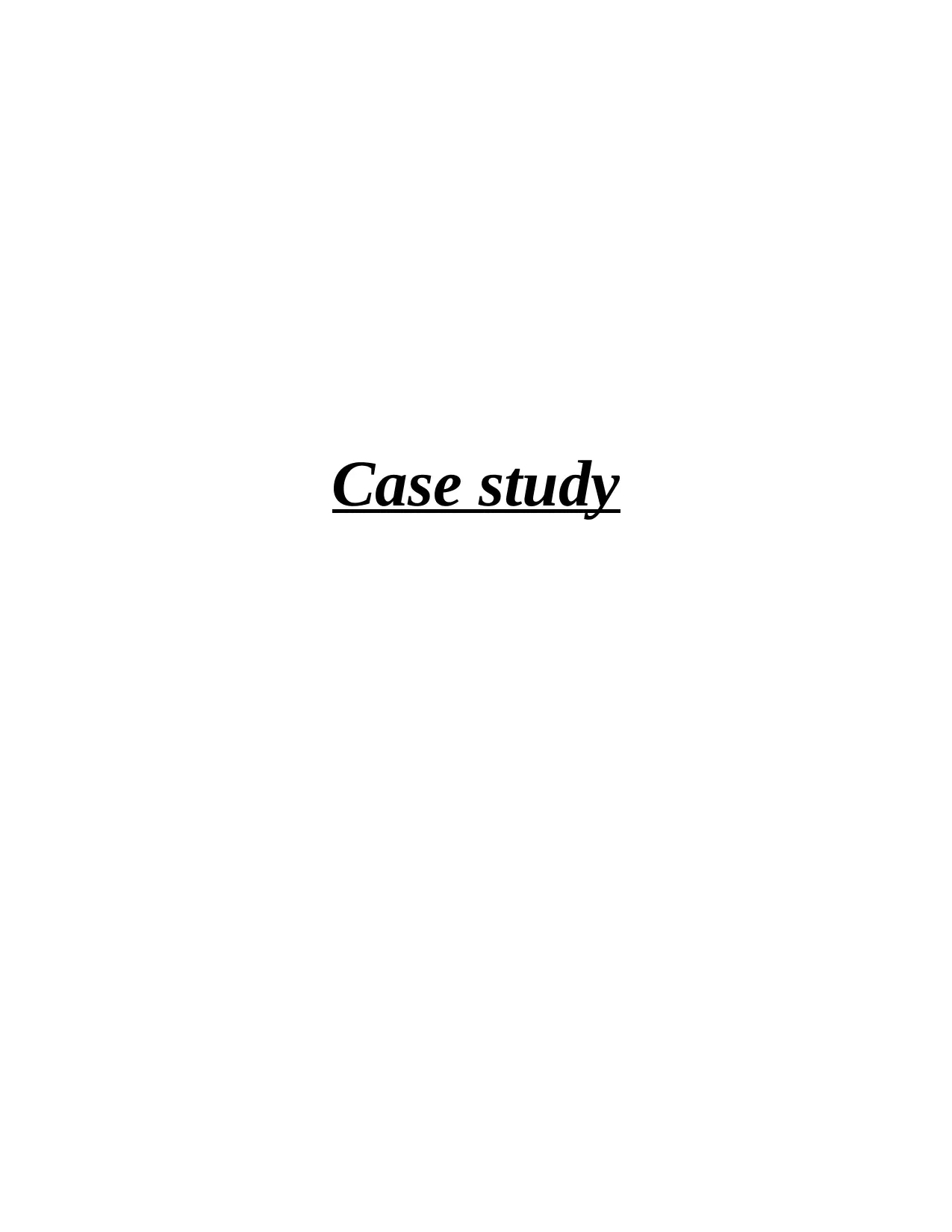
Case study
Paraphrase This Document
Need a fresh take? Get an instant paraphrase of this document with our AI Paraphraser
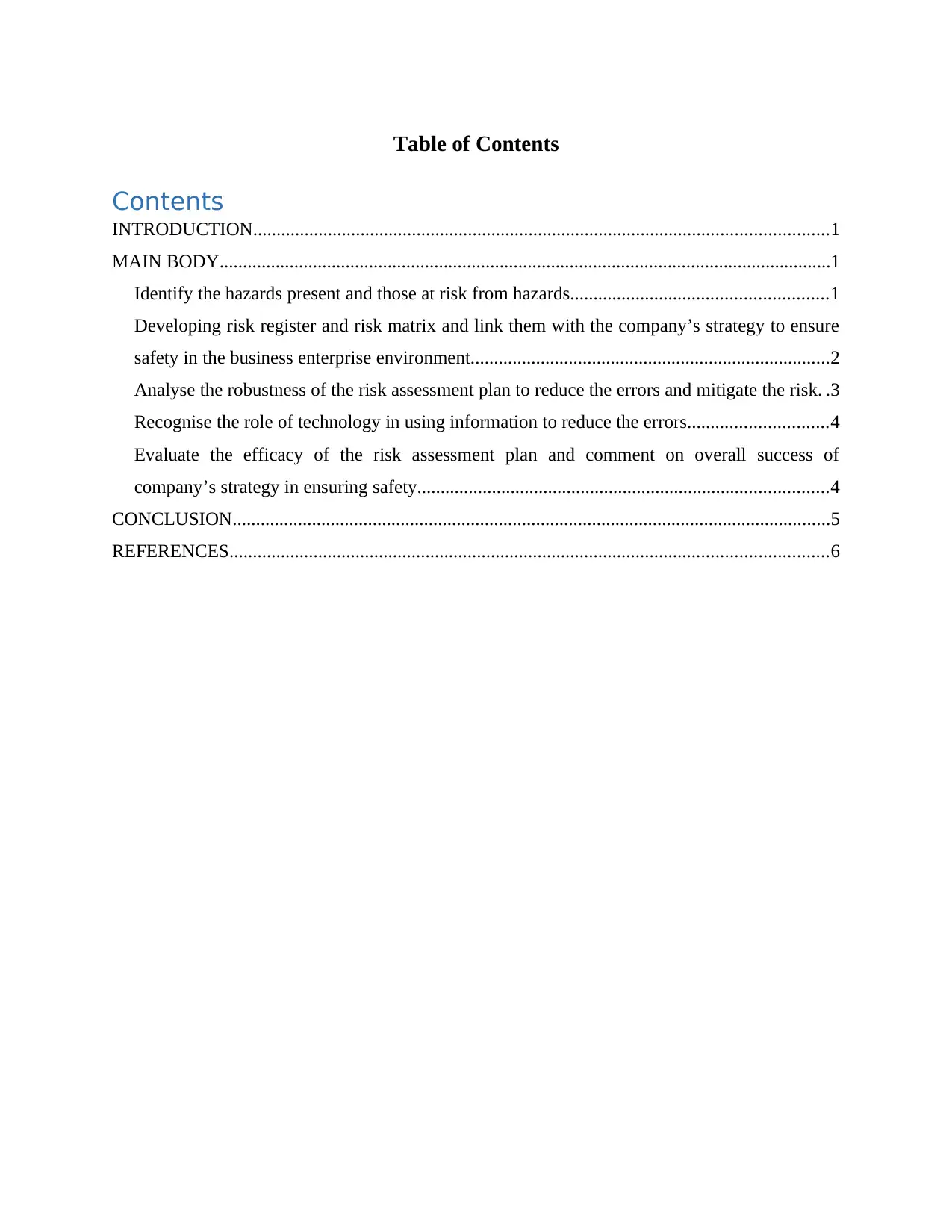
Table of Contents
Contents
INTRODUCTION...........................................................................................................................1
MAIN BODY...................................................................................................................................1
Identify the hazards present and those at risk from hazards.......................................................1
Developing risk register and risk matrix and link them with the company’s strategy to ensure
safety in the business enterprise environment.............................................................................2
Analyse the robustness of the risk assessment plan to reduce the errors and mitigate the risk. .3
Recognise the role of technology in using information to reduce the errors..............................4
Evaluate the efficacy of the risk assessment plan and comment on overall success of
company’s strategy in ensuring safety........................................................................................4
CONCLUSION................................................................................................................................5
REFERENCES................................................................................................................................6
Contents
INTRODUCTION...........................................................................................................................1
MAIN BODY...................................................................................................................................1
Identify the hazards present and those at risk from hazards.......................................................1
Developing risk register and risk matrix and link them with the company’s strategy to ensure
safety in the business enterprise environment.............................................................................2
Analyse the robustness of the risk assessment plan to reduce the errors and mitigate the risk. .3
Recognise the role of technology in using information to reduce the errors..............................4
Evaluate the efficacy of the risk assessment plan and comment on overall success of
company’s strategy in ensuring safety........................................................................................4
CONCLUSION................................................................................................................................5
REFERENCES................................................................................................................................6
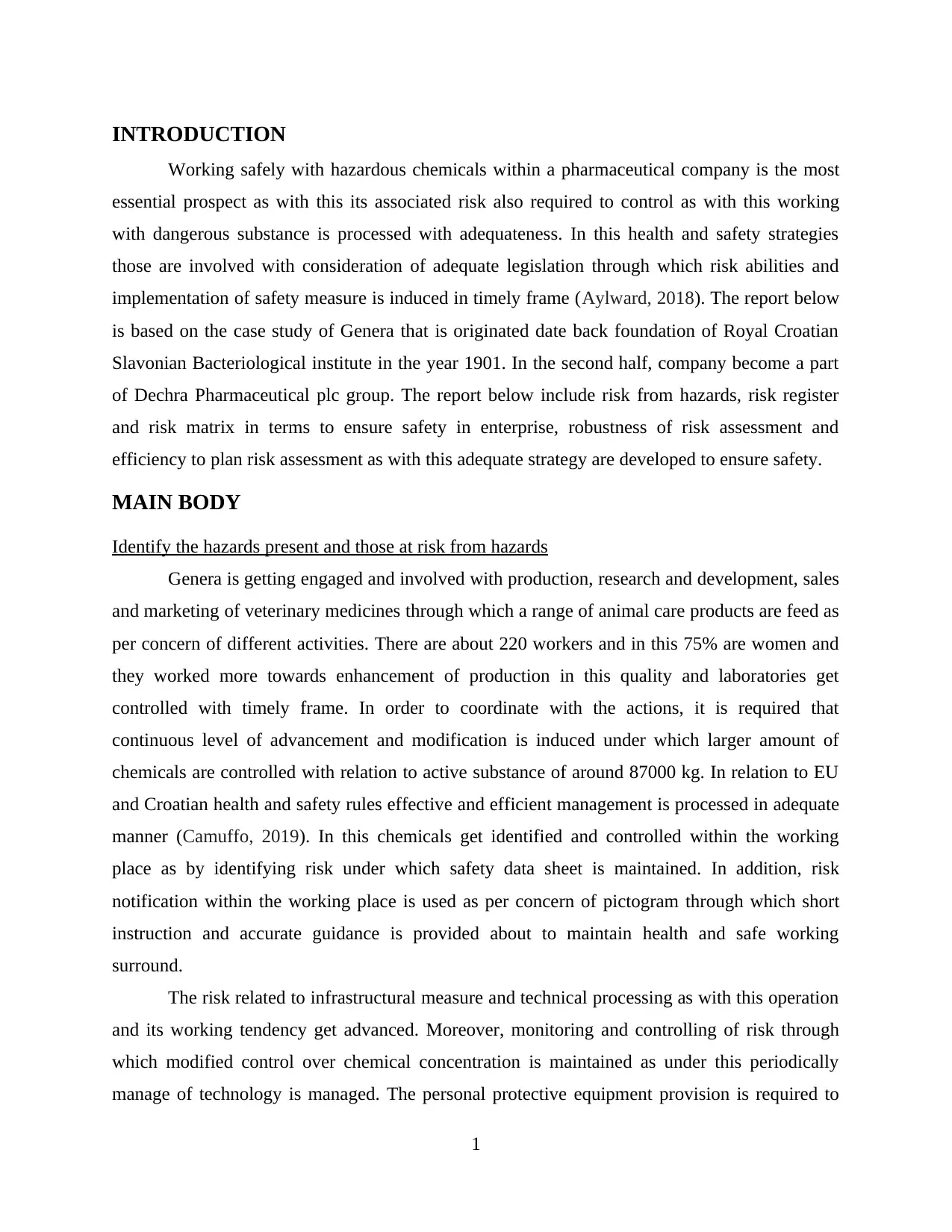
INTRODUCTION
Working safely with hazardous chemicals within a pharmaceutical company is the most
essential prospect as with this its associated risk also required to control as with this working
with dangerous substance is processed with adequateness. In this health and safety strategies
those are involved with consideration of adequate legislation through which risk abilities and
implementation of safety measure is induced in timely frame (Aylward, 2018). The report below
is based on the case study of Genera that is originated date back foundation of Royal Croatian
Slavonian Bacteriological institute in the year 1901. In the second half, company become a part
of Dechra Pharmaceutical plc group. The report below include risk from hazards, risk register
and risk matrix in terms to ensure safety in enterprise, robustness of risk assessment and
efficiency to plan risk assessment as with this adequate strategy are developed to ensure safety.
MAIN BODY
Identify the hazards present and those at risk from hazards
Genera is getting engaged and involved with production, research and development, sales
and marketing of veterinary medicines through which a range of animal care products are feed as
per concern of different activities. There are about 220 workers and in this 75% are women and
they worked more towards enhancement of production in this quality and laboratories get
controlled with timely frame. In order to coordinate with the actions, it is required that
continuous level of advancement and modification is induced under which larger amount of
chemicals are controlled with relation to active substance of around 87000 kg. In relation to EU
and Croatian health and safety rules effective and efficient management is processed in adequate
manner (Camuffo, 2019). In this chemicals get identified and controlled within the working
place as by identifying risk under which safety data sheet is maintained. In addition, risk
notification within the working place is used as per concern of pictogram through which short
instruction and accurate guidance is provided about to maintain health and safe working
surround.
The risk related to infrastructural measure and technical processing as with this operation
and its working tendency get advanced. Moreover, monitoring and controlling of risk through
which modified control over chemical concentration is maintained as under this periodically
manage of technology is managed. The personal protective equipment provision is required to
1
Working safely with hazardous chemicals within a pharmaceutical company is the most
essential prospect as with this its associated risk also required to control as with this working
with dangerous substance is processed with adequateness. In this health and safety strategies
those are involved with consideration of adequate legislation through which risk abilities and
implementation of safety measure is induced in timely frame (Aylward, 2018). The report below
is based on the case study of Genera that is originated date back foundation of Royal Croatian
Slavonian Bacteriological institute in the year 1901. In the second half, company become a part
of Dechra Pharmaceutical plc group. The report below include risk from hazards, risk register
and risk matrix in terms to ensure safety in enterprise, robustness of risk assessment and
efficiency to plan risk assessment as with this adequate strategy are developed to ensure safety.
MAIN BODY
Identify the hazards present and those at risk from hazards
Genera is getting engaged and involved with production, research and development, sales
and marketing of veterinary medicines through which a range of animal care products are feed as
per concern of different activities. There are about 220 workers and in this 75% are women and
they worked more towards enhancement of production in this quality and laboratories get
controlled with timely frame. In order to coordinate with the actions, it is required that
continuous level of advancement and modification is induced under which larger amount of
chemicals are controlled with relation to active substance of around 87000 kg. In relation to EU
and Croatian health and safety rules effective and efficient management is processed in adequate
manner (Camuffo, 2019). In this chemicals get identified and controlled within the working
place as by identifying risk under which safety data sheet is maintained. In addition, risk
notification within the working place is used as per concern of pictogram through which short
instruction and accurate guidance is provided about to maintain health and safe working
surround.
The risk related to infrastructural measure and technical processing as with this operation
and its working tendency get advanced. Moreover, monitoring and controlling of risk through
which modified control over chemical concentration is maintained as under this periodically
manage of technology is managed. The personal protective equipment provision is required to
1
⊘ This is a preview!⊘
Do you want full access?
Subscribe today to unlock all pages.

Trusted by 1+ million students worldwide
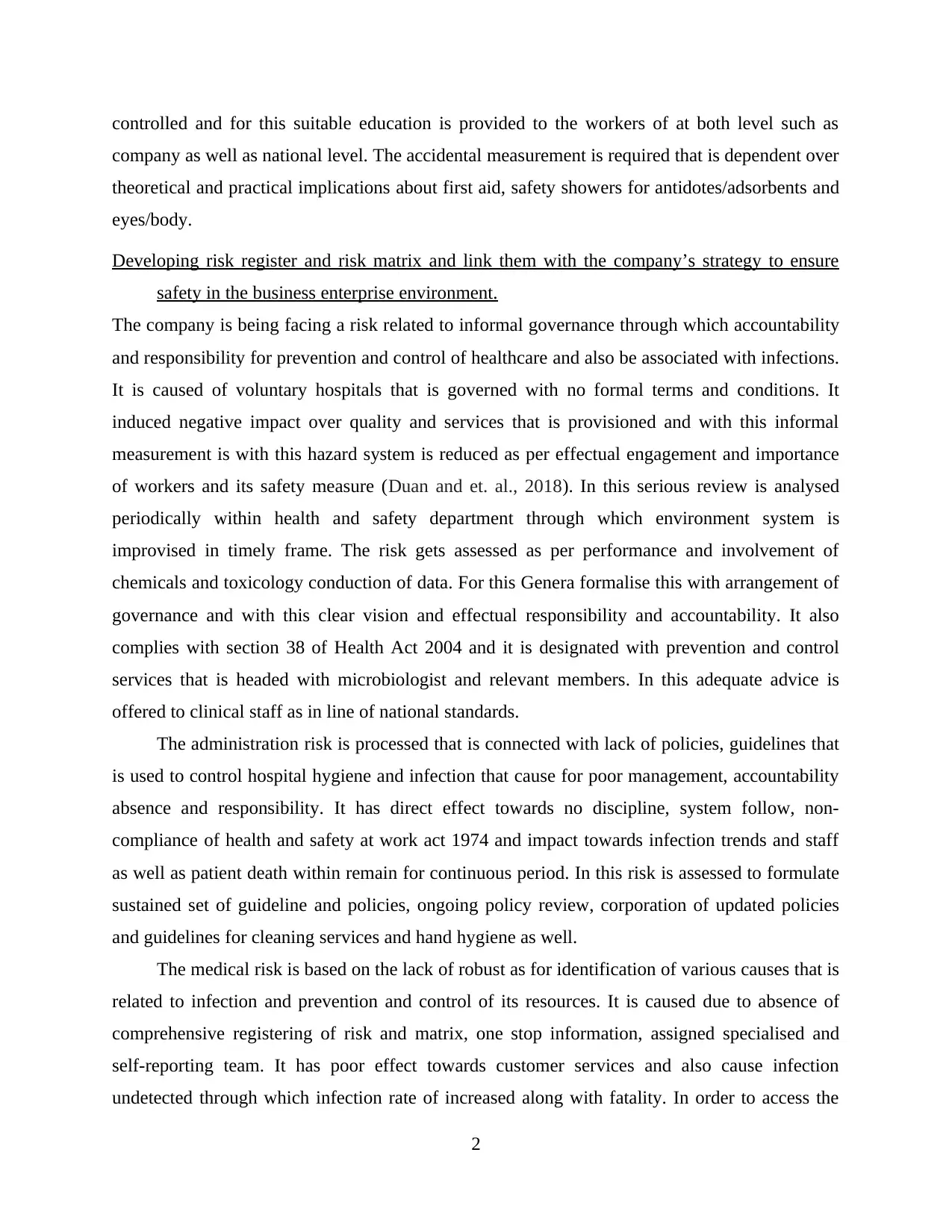
controlled and for this suitable education is provided to the workers of at both level such as
company as well as national level. The accidental measurement is required that is dependent over
theoretical and practical implications about first aid, safety showers for antidotes/adsorbents and
eyes/body.
Developing risk register and risk matrix and link them with the company’s strategy to ensure
safety in the business enterprise environment.
The company is being facing a risk related to informal governance through which accountability
and responsibility for prevention and control of healthcare and also be associated with infections.
It is caused of voluntary hospitals that is governed with no formal terms and conditions. It
induced negative impact over quality and services that is provisioned and with this informal
measurement is with this hazard system is reduced as per effectual engagement and importance
of workers and its safety measure (Duan and et. al., 2018). In this serious review is analysed
periodically within health and safety department through which environment system is
improvised in timely frame. The risk gets assessed as per performance and involvement of
chemicals and toxicology conduction of data. For this Genera formalise this with arrangement of
governance and with this clear vision and effectual responsibility and accountability. It also
complies with section 38 of Health Act 2004 and it is designated with prevention and control
services that is headed with microbiologist and relevant members. In this adequate advice is
offered to clinical staff as in line of national standards.
The administration risk is processed that is connected with lack of policies, guidelines that
is used to control hospital hygiene and infection that cause for poor management, accountability
absence and responsibility. It has direct effect towards no discipline, system follow, non-
compliance of health and safety at work act 1974 and impact towards infection trends and staff
as well as patient death within remain for continuous period. In this risk is assessed to formulate
sustained set of guideline and policies, ongoing policy review, corporation of updated policies
and guidelines for cleaning services and hand hygiene as well.
The medical risk is based on the lack of robust as for identification of various causes that is
related to infection and prevention and control of its resources. It is caused due to absence of
comprehensive registering of risk and matrix, one stop information, assigned specialised and
self-reporting team. It has poor effect towards customer services and also cause infection
undetected through which infection rate of increased along with fatality. In order to access the
2
company as well as national level. The accidental measurement is required that is dependent over
theoretical and practical implications about first aid, safety showers for antidotes/adsorbents and
eyes/body.
Developing risk register and risk matrix and link them with the company’s strategy to ensure
safety in the business enterprise environment.
The company is being facing a risk related to informal governance through which accountability
and responsibility for prevention and control of healthcare and also be associated with infections.
It is caused of voluntary hospitals that is governed with no formal terms and conditions. It
induced negative impact over quality and services that is provisioned and with this informal
measurement is with this hazard system is reduced as per effectual engagement and importance
of workers and its safety measure (Duan and et. al., 2018). In this serious review is analysed
periodically within health and safety department through which environment system is
improvised in timely frame. The risk gets assessed as per performance and involvement of
chemicals and toxicology conduction of data. For this Genera formalise this with arrangement of
governance and with this clear vision and effectual responsibility and accountability. It also
complies with section 38 of Health Act 2004 and it is designated with prevention and control
services that is headed with microbiologist and relevant members. In this adequate advice is
offered to clinical staff as in line of national standards.
The administration risk is processed that is connected with lack of policies, guidelines that
is used to control hospital hygiene and infection that cause for poor management, accountability
absence and responsibility. It has direct effect towards no discipline, system follow, non-
compliance of health and safety at work act 1974 and impact towards infection trends and staff
as well as patient death within remain for continuous period. In this risk is assessed to formulate
sustained set of guideline and policies, ongoing policy review, corporation of updated policies
and guidelines for cleaning services and hand hygiene as well.
The medical risk is based on the lack of robust as for identification of various causes that is
related to infection and prevention and control of its resources. It is caused due to absence of
comprehensive registering of risk and matrix, one stop information, assigned specialised and
self-reporting team. It has poor effect towards customer services and also cause infection
undetected through which infection rate of increased along with fatality. In order to access the
2
Paraphrase This Document
Need a fresh take? Get an instant paraphrase of this document with our AI Paraphraser
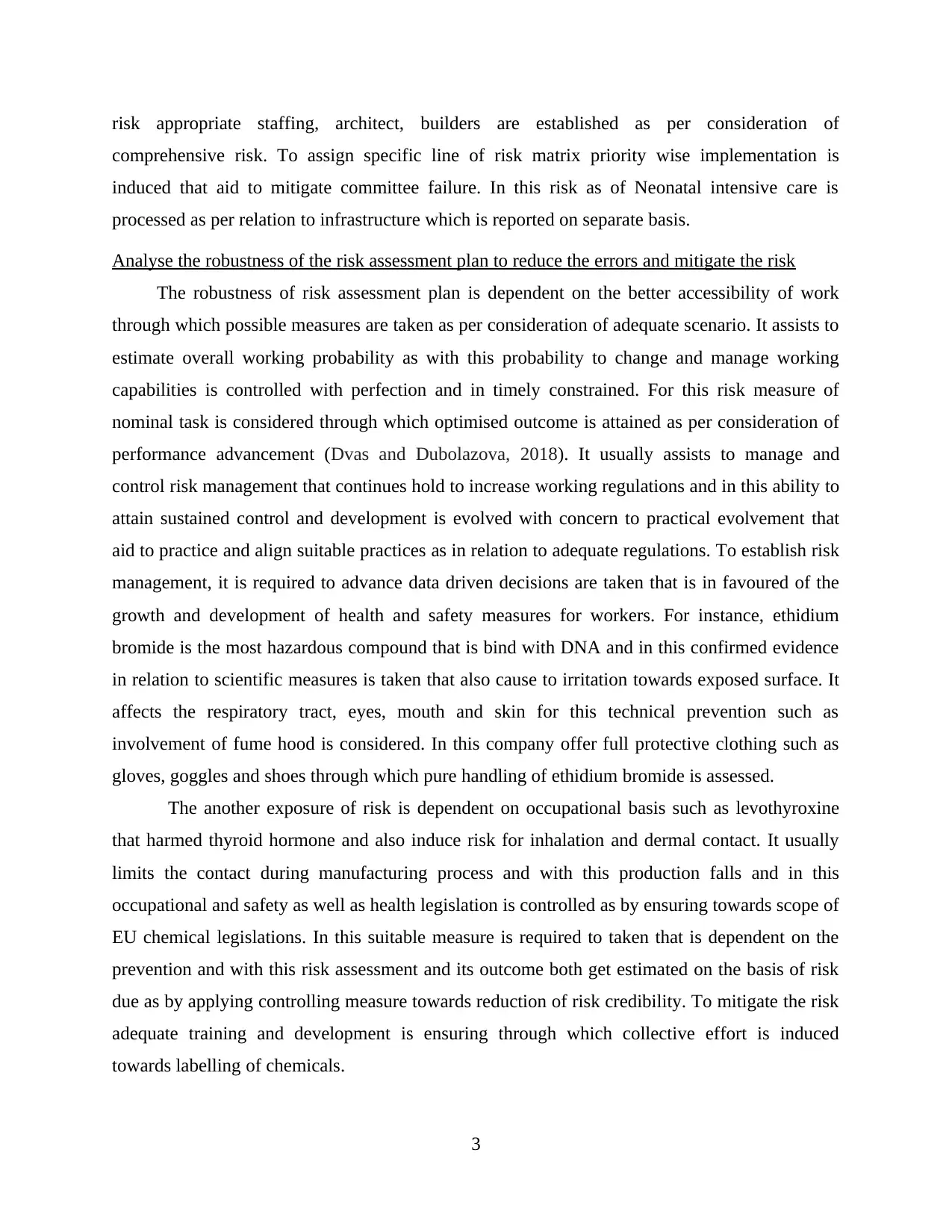
risk appropriate staffing, architect, builders are established as per consideration of
comprehensive risk. To assign specific line of risk matrix priority wise implementation is
induced that aid to mitigate committee failure. In this risk as of Neonatal intensive care is
processed as per relation to infrastructure which is reported on separate basis.
Analyse the robustness of the risk assessment plan to reduce the errors and mitigate the risk
The robustness of risk assessment plan is dependent on the better accessibility of work
through which possible measures are taken as per consideration of adequate scenario. It assists to
estimate overall working probability as with this probability to change and manage working
capabilities is controlled with perfection and in timely constrained. For this risk measure of
nominal task is considered through which optimised outcome is attained as per consideration of
performance advancement (Dvas and Dubolazova, 2018). It usually assists to manage and
control risk management that continues hold to increase working regulations and in this ability to
attain sustained control and development is evolved with concern to practical evolvement that
aid to practice and align suitable practices as in relation to adequate regulations. To establish risk
management, it is required to advance data driven decisions are taken that is in favoured of the
growth and development of health and safety measures for workers. For instance, ethidium
bromide is the most hazardous compound that is bind with DNA and in this confirmed evidence
in relation to scientific measures is taken that also cause to irritation towards exposed surface. It
affects the respiratory tract, eyes, mouth and skin for this technical prevention such as
involvement of fume hood is considered. In this company offer full protective clothing such as
gloves, goggles and shoes through which pure handling of ethidium bromide is assessed.
The another exposure of risk is dependent on occupational basis such as levothyroxine
that harmed thyroid hormone and also induce risk for inhalation and dermal contact. It usually
limits the contact during manufacturing process and with this production falls and in this
occupational and safety as well as health legislation is controlled as by ensuring towards scope of
EU chemical legislations. In this suitable measure is required to taken that is dependent on the
prevention and with this risk assessment and its outcome both get estimated on the basis of risk
due as by applying controlling measure towards reduction of risk credibility. To mitigate the risk
adequate training and development is ensuring through which collective effort is induced
towards labelling of chemicals.
3
comprehensive risk. To assign specific line of risk matrix priority wise implementation is
induced that aid to mitigate committee failure. In this risk as of Neonatal intensive care is
processed as per relation to infrastructure which is reported on separate basis.
Analyse the robustness of the risk assessment plan to reduce the errors and mitigate the risk
The robustness of risk assessment plan is dependent on the better accessibility of work
through which possible measures are taken as per consideration of adequate scenario. It assists to
estimate overall working probability as with this probability to change and manage working
capabilities is controlled with perfection and in timely constrained. For this risk measure of
nominal task is considered through which optimised outcome is attained as per consideration of
performance advancement (Dvas and Dubolazova, 2018). It usually assists to manage and
control risk management that continues hold to increase working regulations and in this ability to
attain sustained control and development is evolved with concern to practical evolvement that
aid to practice and align suitable practices as in relation to adequate regulations. To establish risk
management, it is required to advance data driven decisions are taken that is in favoured of the
growth and development of health and safety measures for workers. For instance, ethidium
bromide is the most hazardous compound that is bind with DNA and in this confirmed evidence
in relation to scientific measures is taken that also cause to irritation towards exposed surface. It
affects the respiratory tract, eyes, mouth and skin for this technical prevention such as
involvement of fume hood is considered. In this company offer full protective clothing such as
gloves, goggles and shoes through which pure handling of ethidium bromide is assessed.
The another exposure of risk is dependent on occupational basis such as levothyroxine
that harmed thyroid hormone and also induce risk for inhalation and dermal contact. It usually
limits the contact during manufacturing process and with this production falls and in this
occupational and safety as well as health legislation is controlled as by ensuring towards scope of
EU chemical legislations. In this suitable measure is required to taken that is dependent on the
prevention and with this risk assessment and its outcome both get estimated on the basis of risk
due as by applying controlling measure towards reduction of risk credibility. To mitigate the risk
adequate training and development is ensuring through which collective effort is induced
towards labelling of chemicals.
3
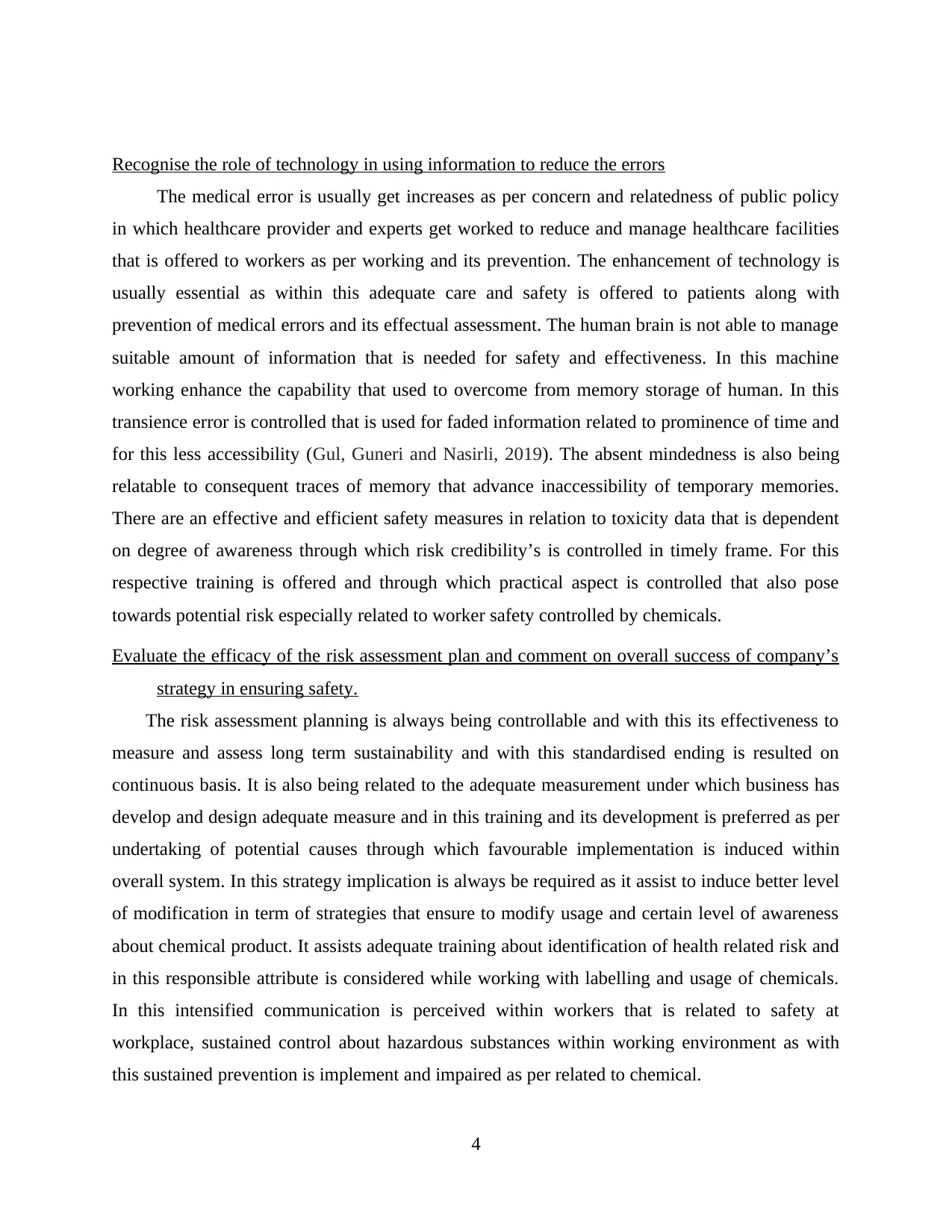
Recognise the role of technology in using information to reduce the errors
The medical error is usually get increases as per concern and relatedness of public policy
in which healthcare provider and experts get worked to reduce and manage healthcare facilities
that is offered to workers as per working and its prevention. The enhancement of technology is
usually essential as within this adequate care and safety is offered to patients along with
prevention of medical errors and its effectual assessment. The human brain is not able to manage
suitable amount of information that is needed for safety and effectiveness. In this machine
working enhance the capability that used to overcome from memory storage of human. In this
transience error is controlled that is used for faded information related to prominence of time and
for this less accessibility (Gul, Guneri and Nasirli, 2019). The absent mindedness is also being
relatable to consequent traces of memory that advance inaccessibility of temporary memories.
There are an effective and efficient safety measures in relation to toxicity data that is dependent
on degree of awareness through which risk credibility’s is controlled in timely frame. For this
respective training is offered and through which practical aspect is controlled that also pose
towards potential risk especially related to worker safety controlled by chemicals.
Evaluate the efficacy of the risk assessment plan and comment on overall success of company’s
strategy in ensuring safety.
The risk assessment planning is always being controllable and with this its effectiveness to
measure and assess long term sustainability and with this standardised ending is resulted on
continuous basis. It is also being related to the adequate measurement under which business has
develop and design adequate measure and in this training and its development is preferred as per
undertaking of potential causes through which favourable implementation is induced within
overall system. In this strategy implication is always be required as it assist to induce better level
of modification in term of strategies that ensure to modify usage and certain level of awareness
about chemical product. It assists adequate training about identification of health related risk and
in this responsible attribute is considered while working with labelling and usage of chemicals.
In this intensified communication is perceived within workers that is related to safety at
workplace, sustained control about hazardous substances within working environment as with
this sustained prevention is implement and impaired as per related to chemical.
4
The medical error is usually get increases as per concern and relatedness of public policy
in which healthcare provider and experts get worked to reduce and manage healthcare facilities
that is offered to workers as per working and its prevention. The enhancement of technology is
usually essential as within this adequate care and safety is offered to patients along with
prevention of medical errors and its effectual assessment. The human brain is not able to manage
suitable amount of information that is needed for safety and effectiveness. In this machine
working enhance the capability that used to overcome from memory storage of human. In this
transience error is controlled that is used for faded information related to prominence of time and
for this less accessibility (Gul, Guneri and Nasirli, 2019). The absent mindedness is also being
relatable to consequent traces of memory that advance inaccessibility of temporary memories.
There are an effective and efficient safety measures in relation to toxicity data that is dependent
on degree of awareness through which risk credibility’s is controlled in timely frame. For this
respective training is offered and through which practical aspect is controlled that also pose
towards potential risk especially related to worker safety controlled by chemicals.
Evaluate the efficacy of the risk assessment plan and comment on overall success of company’s
strategy in ensuring safety.
The risk assessment planning is always being controllable and with this its effectiveness to
measure and assess long term sustainability and with this standardised ending is resulted on
continuous basis. It is also being related to the adequate measurement under which business has
develop and design adequate measure and in this training and its development is preferred as per
undertaking of potential causes through which favourable implementation is induced within
overall system. In this strategy implication is always be required as it assist to induce better level
of modification in term of strategies that ensure to modify usage and certain level of awareness
about chemical product. It assists adequate training about identification of health related risk and
in this responsible attribute is considered while working with labelling and usage of chemicals.
In this intensified communication is perceived within workers that is related to safety at
workplace, sustained control about hazardous substances within working environment as with
this sustained prevention is implement and impaired as per related to chemical.
4
⊘ This is a preview!⊘
Do you want full access?
Subscribe today to unlock all pages.

Trusted by 1+ million students worldwide
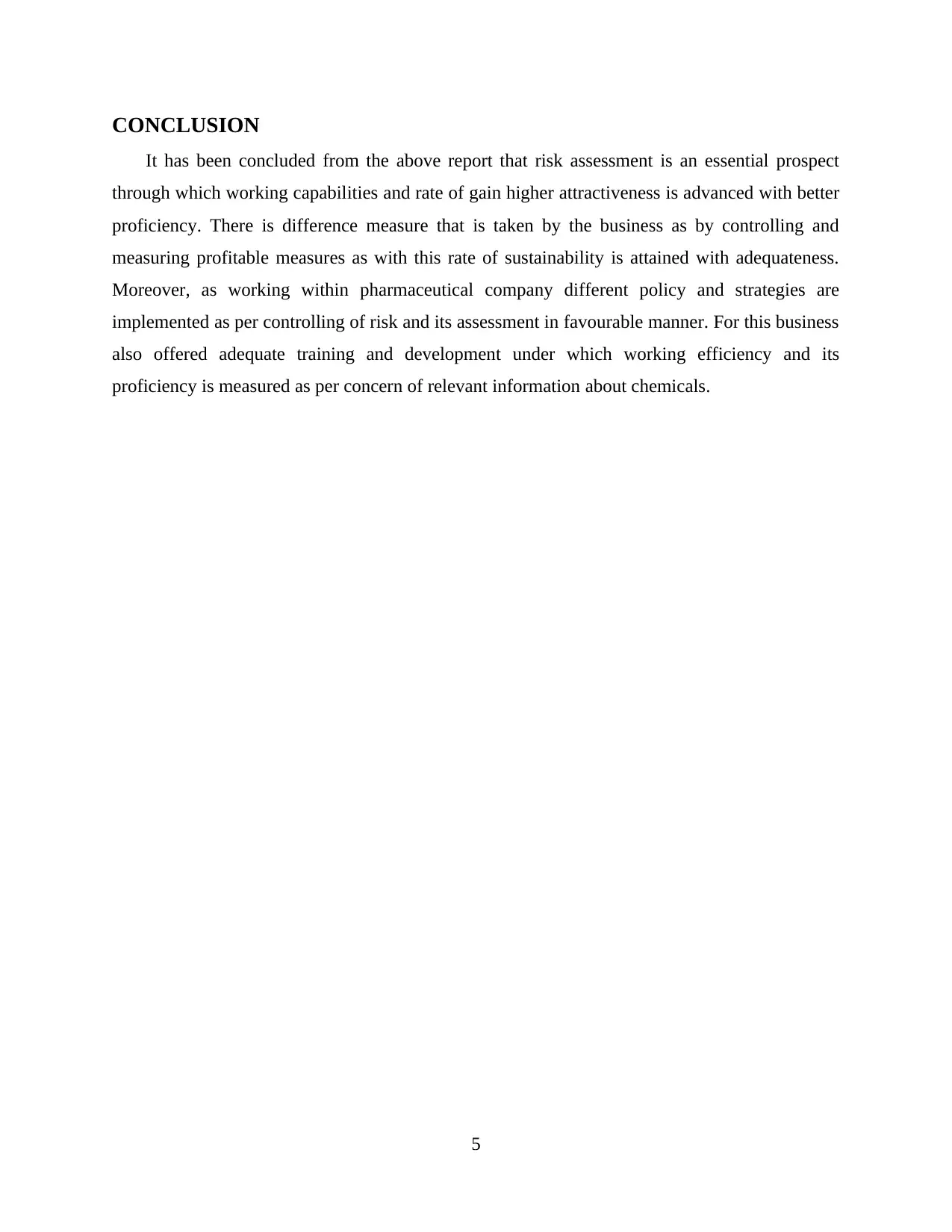
CONCLUSION
It has been concluded from the above report that risk assessment is an essential prospect
through which working capabilities and rate of gain higher attractiveness is advanced with better
proficiency. There is difference measure that is taken by the business as by controlling and
measuring profitable measures as with this rate of sustainability is attained with adequateness.
Moreover, as working within pharmaceutical company different policy and strategies are
implemented as per controlling of risk and its assessment in favourable manner. For this business
also offered adequate training and development under which working efficiency and its
proficiency is measured as per concern of relevant information about chemicals.
5
It has been concluded from the above report that risk assessment is an essential prospect
through which working capabilities and rate of gain higher attractiveness is advanced with better
proficiency. There is difference measure that is taken by the business as by controlling and
measuring profitable measures as with this rate of sustainability is attained with adequateness.
Moreover, as working within pharmaceutical company different policy and strategies are
implemented as per controlling of risk and its assessment in favourable manner. For this business
also offered adequate training and development under which working efficiency and its
proficiency is measured as per concern of relevant information about chemicals.
5
Paraphrase This Document
Need a fresh take? Get an instant paraphrase of this document with our AI Paraphraser
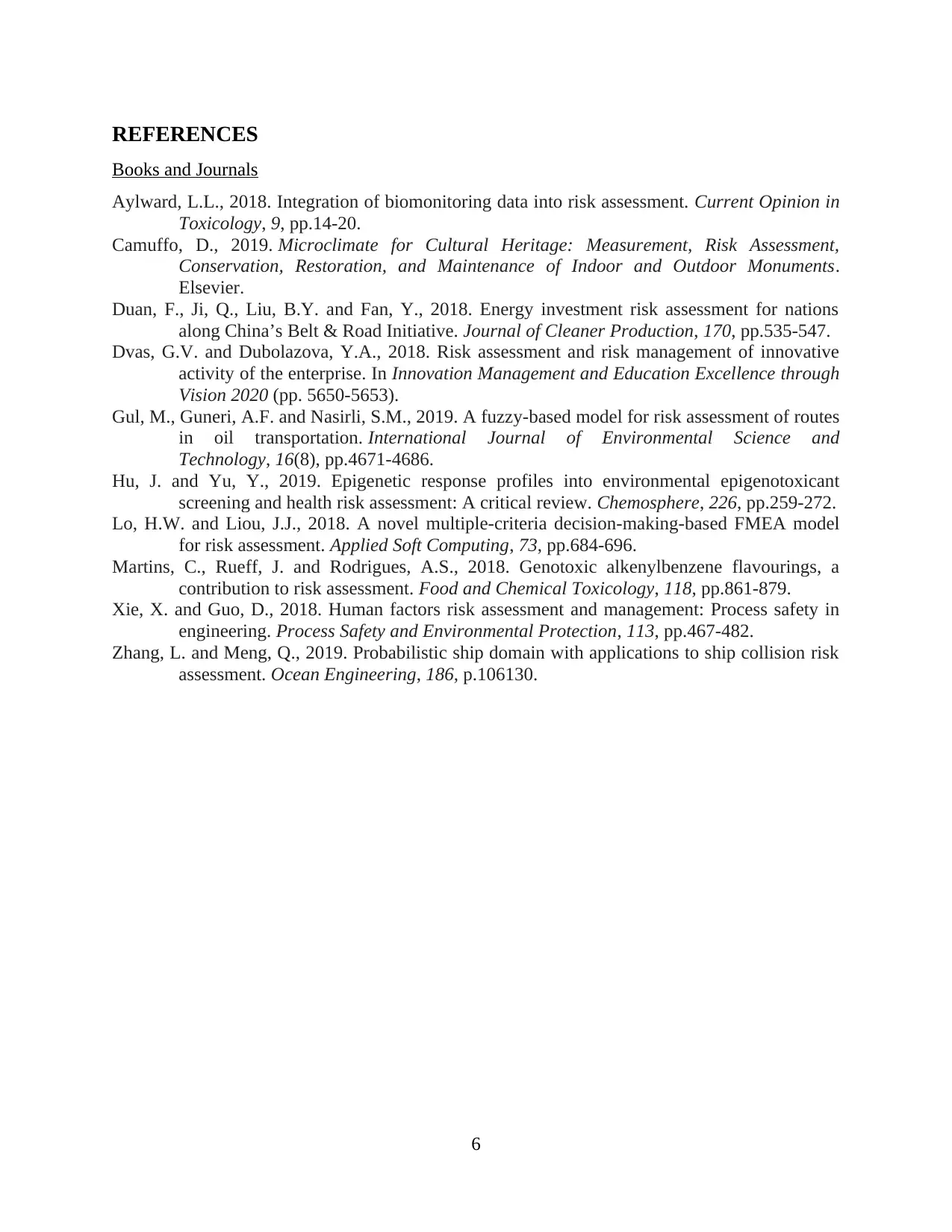
REFERENCES
Books and Journals
Aylward, L.L., 2018. Integration of biomonitoring data into risk assessment. Current Opinion in
Toxicology, 9, pp.14-20.
Camuffo, D., 2019. Microclimate for Cultural Heritage: Measurement, Risk Assessment,
Conservation, Restoration, and Maintenance of Indoor and Outdoor Monuments.
Elsevier.
Duan, F., Ji, Q., Liu, B.Y. and Fan, Y., 2018. Energy investment risk assessment for nations
along China’s Belt & Road Initiative. Journal of Cleaner Production, 170, pp.535-547.
Dvas, G.V. and Dubolazova, Y.A., 2018. Risk assessment and risk management of innovative
activity of the enterprise. In Innovation Management and Education Excellence through
Vision 2020 (pp. 5650-5653).
Gul, M., Guneri, A.F. and Nasirli, S.M., 2019. A fuzzy-based model for risk assessment of routes
in oil transportation. International Journal of Environmental Science and
Technology, 16(8), pp.4671-4686.
Hu, J. and Yu, Y., 2019. Epigenetic response profiles into environmental epigenotoxicant
screening and health risk assessment: A critical review. Chemosphere, 226, pp.259-272.
Lo, H.W. and Liou, J.J., 2018. A novel multiple-criteria decision-making-based FMEA model
for risk assessment. Applied Soft Computing, 73, pp.684-696.
Martins, C., Rueff, J. and Rodrigues, A.S., 2018. Genotoxic alkenylbenzene flavourings, a
contribution to risk assessment. Food and Chemical Toxicology, 118, pp.861-879.
Xie, X. and Guo, D., 2018. Human factors risk assessment and management: Process safety in
engineering. Process Safety and Environmental Protection, 113, pp.467-482.
Zhang, L. and Meng, Q., 2019. Probabilistic ship domain with applications to ship collision risk
assessment. Ocean Engineering, 186, p.106130.
6
Books and Journals
Aylward, L.L., 2018. Integration of biomonitoring data into risk assessment. Current Opinion in
Toxicology, 9, pp.14-20.
Camuffo, D., 2019. Microclimate for Cultural Heritage: Measurement, Risk Assessment,
Conservation, Restoration, and Maintenance of Indoor and Outdoor Monuments.
Elsevier.
Duan, F., Ji, Q., Liu, B.Y. and Fan, Y., 2018. Energy investment risk assessment for nations
along China’s Belt & Road Initiative. Journal of Cleaner Production, 170, pp.535-547.
Dvas, G.V. and Dubolazova, Y.A., 2018. Risk assessment and risk management of innovative
activity of the enterprise. In Innovation Management and Education Excellence through
Vision 2020 (pp. 5650-5653).
Gul, M., Guneri, A.F. and Nasirli, S.M., 2019. A fuzzy-based model for risk assessment of routes
in oil transportation. International Journal of Environmental Science and
Technology, 16(8), pp.4671-4686.
Hu, J. and Yu, Y., 2019. Epigenetic response profiles into environmental epigenotoxicant
screening and health risk assessment: A critical review. Chemosphere, 226, pp.259-272.
Lo, H.W. and Liou, J.J., 2018. A novel multiple-criteria decision-making-based FMEA model
for risk assessment. Applied Soft Computing, 73, pp.684-696.
Martins, C., Rueff, J. and Rodrigues, A.S., 2018. Genotoxic alkenylbenzene flavourings, a
contribution to risk assessment. Food and Chemical Toxicology, 118, pp.861-879.
Xie, X. and Guo, D., 2018. Human factors risk assessment and management: Process safety in
engineering. Process Safety and Environmental Protection, 113, pp.467-482.
Zhang, L. and Meng, Q., 2019. Probabilistic ship domain with applications to ship collision risk
assessment. Ocean Engineering, 186, p.106130.
6
1 out of 8
Related Documents
Your All-in-One AI-Powered Toolkit for Academic Success.
+13062052269
info@desklib.com
Available 24*7 on WhatsApp / Email
![[object Object]](/_next/static/media/star-bottom.7253800d.svg)
Unlock your academic potential
Copyright © 2020–2025 A2Z Services. All Rights Reserved. Developed and managed by ZUCOL.





